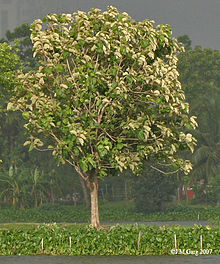
Teak
Teak is the common name for the tropical hardwood tree species Tectona Grandis and its wood products. Also known locally as Jati, Tectona grandis is a large, deciduous tree reaching over 30 m in height in favorable conditions. The crown is open with many small branches; the bole is often buttressed and may be fluted. The leaves are very large, shiny above, hairy below with a vein network about 30 x 20 cm but young leaves can be up to 1 m long.
Its natural distribution is in Southeast Asia, from the Indian subcontinent through Myanmar and Thailand to Laos. Whether the ‘natural’ stands in Indonesia are indigenous is not clearly established. It may have been introduced by Hindu settlers, possibly in the 7th century. It is believed teak was introduced to Java 400-600 years ago from India.
T. grandis will survive and grow under a wide range of climatic conditions. It grows best in a warm, moist, tropical climate with a significant difference between dry and wet seasons. For plantations, trees are initially spaced at 2 x 2 m. Being a deciduous tree, raising pure plantations of teak is discouraged; it is recommended to raise a mixture of 80% mixed indigenous species and the remaining 20% of Tectona Grandis.
Intercropping: Soya bean mixed with Tectona Grandis not only allows harvesting of the bean for food, it makes the trees grow better. The soya stems, roots and leaves are added to the soil as fertilizer and to stabilize the soil.
Uses: A rare combination of superior physical and mechanical properties makes Teak an ideal timber, with no likelihood of being surpassed by another species. The wood is a medium density and hardness timber. The heartwood is often red or yellow and even green when freshly cut but turns golden brow after exposure. Grain is straight or wavy with somewhat irregular texture. The wood is oily to the touch and when freshly cut has a smell suggestive of leather. Being classified as very resistant to teredo activity, the wood is excellent timber for bridge building and other construction in contact with water such as docks, quays, piers and floodgates in fresh water. In house building, teakwood is particularly suitable for interior and exterior joinery (windows, solid panel doors and framing) and is used for floors exposed to light to moderate pedestrian traffic. It is also used quite extensively for garden furniture. It is brittle and therefore less suitable for articles requiring high resilience, such as tool handles and sporting goods. Its high resistance to a wide variety of chemicals makes it ideal for laboratory and kitchen tables. The wood grains are figured well, producing an attractive veneer, which is extensively used in the manufacture of furniture and interior fittings. The wood is very durable, saws fairly and seasons easily. For the export market, teakwood is recommended for ship decking and other constructional work in boat building. Tectona Grandis is economically one of the most important timber tree species of Indonesia. Tannin or dyestuff: Both the rootbark and the young leaves produce a yellowish-brown or reddish dye, which is used for paper, clothes and matting. Medicine: In traditional medicine, a wood powder paste has been used against bilious headaches and swellings and internally against dermatitis or as a vermifuge. The charred wood soaked in poppy juice and made into a paste has been used to relieve the swelling of the eyelids. The bark has been used as an astringent and the wood as a hair tonic. Other products: Sawdust from teakwood is used as incense in Java; the dust, however, may irritate the skin.

